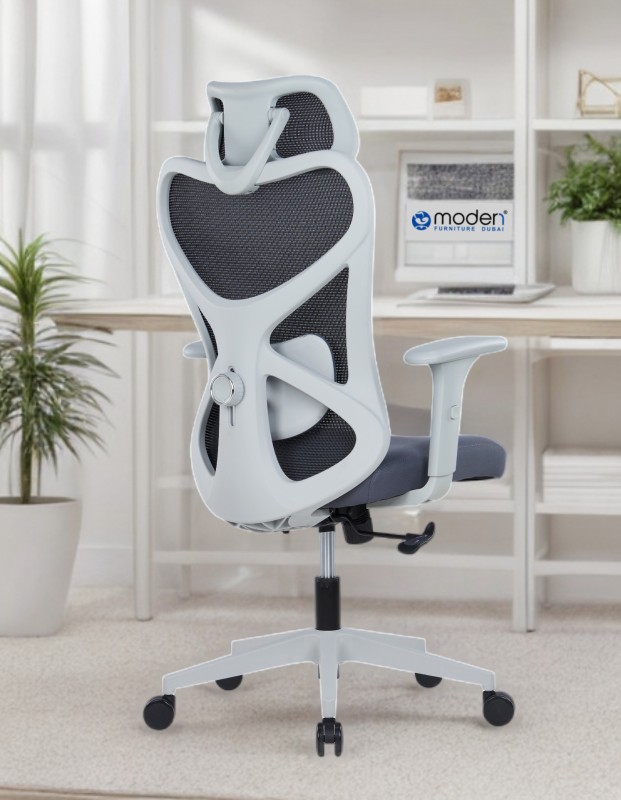
The Role of Office Chair Design in Reducing Eye Strain and Neck Pain
Introduction
Working long hours in front of a computer screen can lead to a range of health issues, including eye strain and neck pain. However, the right office chair can play a crucial role in alleviating these problems. A well-designed ergonomic chair can not only support your back but also improve your posture, reduce strain on your neck, and help prevent eye discomfort. In this article, we’ll discuss how office chair design influences your physical health and how certain features can be used to mitigate common issues such as eye strain and neck pain.
1. The Connection Between Posture and Neck Pain
Neck pain is one of the most common issues faced by office workers, often caused by poor posture. Sitting in a slouched or hunched position can place unnecessary strain on the neck muscles, leading to discomfort and long-term pain. An office chair with adjustable features, such as a high backrest and neck support, encourages proper posture and helps reduce the risk of neck strain. The key is to maintain the natural curvature of your spine, which reduces the pressure on your neck and shoulders.
2. How Chair Backrests Support Healthy Posture
The backrest of an office chair is essential in promoting good posture. A chair with a high backrest supports the entire back, including the neck and upper spine. When choosing an office chair, look for one that offers adjustable back support to ensure it fits the natural curve of your spine. This feature helps in keeping your upper body aligned, reducing the need to strain your neck and back, ultimately preventing discomfort and long-term damage.
3. The Role of Headrests in Preventing Neck Strain
Headrests are one of the most effective features in an office chair for preventing neck pain. A headrest provides support to your head and neck, particularly when leaning back in the chair. This feature is especially important during long work sessions when you need to take short breaks or relax. A well-positioned headrest can also encourage the correct posture by keeping your head in alignment with your spine, which helps prevent muscle tension in your neck.
4. Adjustable Seat Depth and Its Impact on Neck Alignment
Seat depth is another important consideration when selecting an office chair. The seat should be deep enough to support your thighs but not so deep that it forces you to lean forward to reach the desk. When your seat depth is properly adjusted, your body maintains a neutral posture, allowing your neck and shoulders to stay aligned with your spine. This reduces the likelihood of tension in the neck area.
5. Lumbar Support and Its Contribution to Spine Health
Lumbar support plays a key role in preventing neck and back pain. The lumbar region of the spine, or lower back, is particularly vulnerable to strain. An ergonomic chair with built-in lumbar support helps maintain the natural curve of your lower back. By providing support in this area, it encourages a neutral spine position, which reduces the risk of misalignment and compensatory tension in the neck and shoulders.
6. Armrests and Their Role in Reducing Neck and Shoulder Strain
While armrests are primarily designed to support the arms, they also contribute to reducing neck and shoulder strain. Well-adjusted armrests allow you to rest your arms comfortably, which helps avoid excessive tension in your neck and shoulders. Keeping your arms at a 90-degree angle and your wrists relaxed can prevent the need to raise or lean forward, which in turn prevents neck and shoulder discomfort.
7. The Importance of Seat Height Adjustment
A properly adjusted seat height is essential for maintaining an ergonomic posture. When your chair is set at the correct height, your feet should rest flat on the floor with your knees at a 90-degree angle. This alignment promotes a neutral spine and minimizes the chances of slouching, which can lead to neck and back pain. Many modern office chairs offer seat height adjustability, making it easy to find the optimal setting for your body.
8. Eye Strain and Its Link to Desk Setup
Eye strain often results from poor desk setup, such as an improperly positioned monitor or inadequate lighting. While an office chair can alleviate neck strain, it also plays a role in preventing eye strain by encouraging the correct sitting posture. An ergonomic chair allows you to adjust your sitting angle and monitor distance so that your eyes are at the appropriate level. By ensuring that your screen is positioned at eye level and the chair provides proper lumbar support, you can prevent both eye and neck discomfort.
9. The Role of Movement and Flexibility in Reducing Discomfort
A chair that offers flexibility and movement is crucial for reducing the risk of both neck pain and eye strain. Sitting in one position for too long can cause stiffness in the neck and shoulders, which can exacerbate discomfort. Choose a chair that allows you to adjust your position and encourages movement throughout the day. Features like tilt adjustment and swivel functions promote dynamic sitting, which helps keep your muscles and joints from stiffening.
10. Recommended Products for Reducing Eye Strain and Neck Pain
Here are two excellent office chairs designed to reduce eye strain and neck pain:
Recommended Products

-
Ucomfort Super Ergonomic Executive Office Chair (High Back, White)
The Ucomfort Super Ergonomic Executive Office Chair features an adjustable high backrest and headrest, which provide excellent support for your neck and back. Its ergonomic design helps reduce strain on the neck, shoulders, and eyes by encouraging proper posture and alignment throughout the day.
-
Lirbo Executive High Back Ergonomic Chair (Grey)
The Lirbo Executive High Back Ergonomic Chair offers exceptional lumbar and neck support, making it a great choice for reducing neck pain and promoting healthy posture. The chair's adjustable backrest and headrest ensure that your neck remains properly aligned, while its overall design helps reduce the risk of eye strain and discomfort.
FAQs
1. Can an office chair really help prevent neck pain?
Yes, an ergonomic office chair with proper lumbar support, a high backrest, and an adjustable headrest can significantly reduce the risk of neck pain by promoting proper posture and spinal alignment.2. How does the right office chair reduce eye strain?
By ensuring that your desk and monitor are set up at the right height and distance, an ergonomic chair encourages the correct posture, which can reduce eye strain caused by improper viewing angles.3. What features should I look for in an office chair to reduce neck pain?
Look for an office chair with adjustable lumbar support, a high backrest, and a headrest that provides proper neck support. Additionally, features like adjustable seat height and armrests contribute to comfort and reduced strain.4. Is a chair with a headrest necessary for neck pain relief?
While a headrest is not absolutely necessary, it can be highly beneficial in reducing neck strain, especially during long periods of sitting. A headrest provides support to your head and neck, promoting better posture and comfort.


